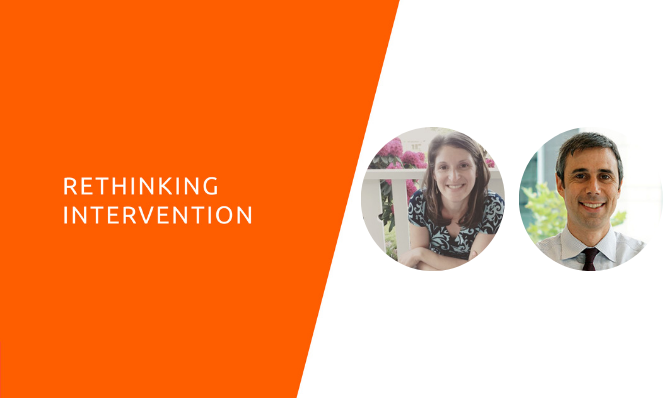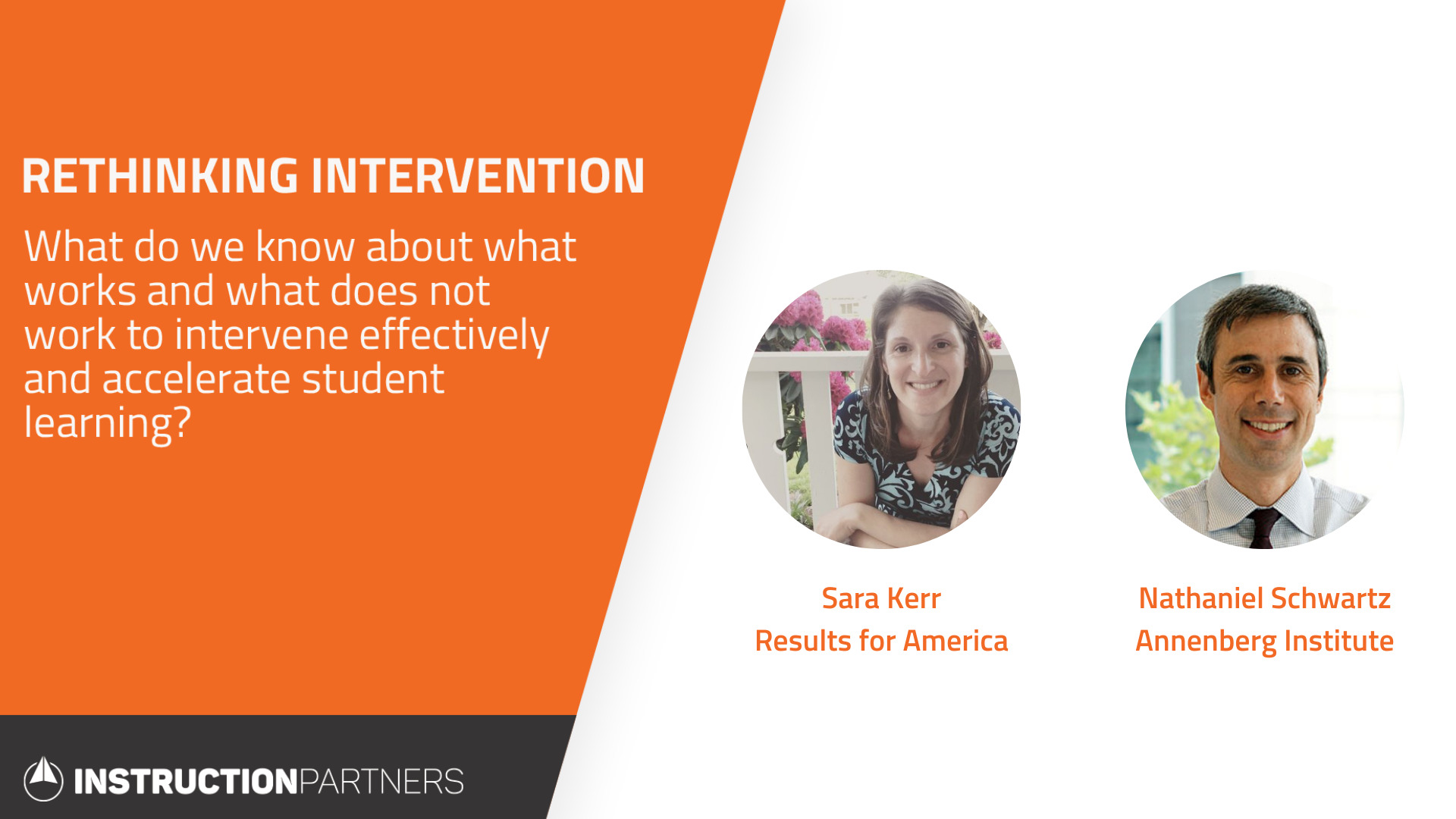
Sara Kerr and Nate Schwartz, EdResearch for Recovery
Sara Kerr is the Vice President of Education Policy Implementation for Results for America, and Nate Schwartz is a professor of practice at the Annenberg Institute for School Reform at Brown University. Sara and Nate spoke to Emily Freitag about EdResearch for Recovery, a project to share research from across the country to inform recovery strategies for this school year.
This conversation took place on July 28, 2020. Watch the full conversation or read the abridged Q&A below.

EF: Sara, I would love to start with you and hear about your personal learning journey and how that informs your perspective on learning.
SK: I will start by saying that I feel my own personal learning journey is an ongoing evolution. I approach this project and in particular, this moment in a pandemic and all of its implications on how we live our day to day lives and how we do school as an ongoing learning journey. Many of us are learning as we go right now. But looking back, learning and school itself always came really easily for me. I am the daughter and granddaughter and actually great-granddaughter of public school teachers. So, in addition to my own experiences in school, I had the good fortune to spend a lot of time in schools with my mother and grandmother in their classrooms. My own experiences and personal view is really cemented in those experiences. I remember from an early age wanting to go into education, wanting to be a teacher. All of my earliest memories are of being surrounded by teaching and learning, both in school and from my family being a family of educators. Through that lens, I think it was clear to me from a really early age that while learning came easy for me and I had an early love for it, that wasn’t true for all kids. Especially the kids in my mom’s classroom who were recent immigrants to the US, who had this dual challenge of not only recently coming to the US and having to learn the language and the culture, but she taught students who often didn’t experience formal learning in the countries from which they emigrated. They had this really interesting set of challenges and dynamics at play. I was viewing that through my privileged lens. Because I was lucky enough to have the mother I did who happens to be an immigrant herself, and so had sat in the shoes of students that she was teaching, the version of the narrative that I heard really early on was not one of “Those kids aren’t as smart or as motivated or don’t have the same love of school,” or, “Those kids are behind others,” which really, I think is the deficit mindset that we see a lot still, unfortunately, in our public school systems. And instead, she said, Here’s how we can really come together as a community to wrap supports around these really capable, talented kids who have overcome incredible odds to even sit in these classrooms today, and whose parents put their own lives at risk to give their kids a better opportunity. Lots of which were educationally motivated, they wanted their kids to have a better education by coming to the US. And so, her perspective was always “Look at these amazing kids and watch what they can do if we support them.” That really stuck with me and has been kind of at the core of my own perspective as a learner. Really my view of learning is both recognizing my own privilege and the joy that I always found in learning, and recognizing that every kid deserves and can have this experience as long as they’re fortunate enough to have really excellent educators in their lives, who really believe in their assets and don’t get mired in their deficits. So my view is that we need to invest in having really excellent, wonderful, caring, talented, smart adults who are working with kids to really share that perspective. And that makes a huge difference.
EF: Thank you for sharing that. Let’s shift into some of the work you all have been doing. Nate, across the research that you all have looked at, what are some things that educators should hold on to as we are approaching this very unbelievable year?
NS: I think the problem we’re facing now is that what we know works and we can see this across the set of research briefs that we’re producing through EdResearch for Recovery, often conflicts with what feels doable. The thing that seems to work is highly personalized instruction built around a strong curriculum and conducted between teachers and students who have developed trusting relationships that provide motivation and inspiration for both the teachers and the students. This has always been true but feels particularly true now, and our lives and schools aren’t set up to make this easily possible.
We can sort of see this in the scramble across districts in the US to recreate the wheel as they each look for ideas and resources to deal through the pandemic, and it feels like there aren’t really strong systems for propagating innovations. It takes tremendous time, tremendous money and heroic efforts on the parts of schools and families. The places that succeed appear to be those that have created these sort of protected systems for delivering new kinds of instruction—and the good news from the research briefs that we’re producing is that there are strong examples out there. For example, we put out a brief on intensive intervention for students who have fallen far behind. We see in that brief the ways that some districts and some charter systems have found ways to integrate small group tutoring into the school day in ways that actually directly sync up with student coursework and what they’re doing outside of the tutoring groups. We see evidence that extended or double-dose course time can work, but only when it’s paired with resources for teachers who can transform their delivery of previously taught material into something different that provides kind of an accelerating push for the students. Our brief on broader supports for students talks about the ways that providing strategic support to families in the form of carefully crafted text messages, video contacts, even just better student home reading materials can raise literacy achievement. We write about serving students with disabilities and our authors describe the importance of ensuring that special education teachers have the time and space to deliver research-based interventions, especially now. They have an interesting point against co-teaching because while they believe that special education students need to spend as much of their time as possible in traditional classrooms, they also think that co-teaching often turns into a special education teacher who sits on the side and watches as a teacher delivers standard instruction versus this research-based intervention that we see can be so useful for special education students. There are a bunch of these examples, but as I said before, I think what’s hard is the way these things often exist in micro-pockets where, for one reason or another, a small school system was able to create the conditions for additional tutors or for interventionists in a way that can be very hard when you’re looking at scale.
One last addition is that the thing that I find hopeful about this moment amidst all of the disheartening, is that I think it actually is prompting some discussions about what it would take to do some of these things at a greater scale for the students who often get shut out of these solutions. There’s a discussion about AmeriCorps tutors. There’s a discussion about how to change federal funding so that schools are actually able to open up in a different way than before. There are new discussions about equity in schools. I think all those could lead somewhere.
EF: I was struck in your papers around this notion of tutoring. It keeps coming up as one of the interventions that is just so effective. What did you all find there? What versions of tutoring did you find to be effective? What could that look like?
NS: What we currently know is that, unlike many of these interventions, people have tried tutoring interventions in a bunch of different places, in different kinds of school systems, and across math and reading. They have done this and in repeated ways and in randomized ways so that you’re able to actually measure the effects, and they have repeatedly found strong positive effects.
I think the studies that have shown those effects follow on a series of studies during No Child Left Behind where there were supplemental education services that actually didn’t look very strong. I would love to have some of these other researchers on this podcast as well, but my read is that the biggest difference is the level of integration with what students are already learning across their other classes. And you see in the places that have done this well that they have found ways to create time within the school day for the tutoring, create real conversations between teachers and tutors about what it is that students are focused on, and then make tutoring feel sustained over time that allows you to develop these trusting relationships between kids, teachers, and tutors that are often absent when it’s just an outside vendor coming in out of the blue for a short time and doing something separate.
EF: Sara, why don’t you take us into what you all found that we often try that doesn’t work?
SK: One thing I’ll say is you were both talking now about the pretty irrefutable evidence on the impact of tutoring, particularly when the models adhere to the conditions that you just described. I find myself in many different conversations right now about the evidence that we have to support this and wondering what that means for this moment we find ourselves in. I think it would be a really interesting conversation to have on this podcast or outside of it of how we set up models that center equity. In particular, right now I hear lots of conversations,
EF: About pods?
SK: About pods, for example, right, where I think we will see a version of this effective one-on-one tutoring or small group tutoring model play out. I really encourage us all to think about what that means. Who will get these really effective one-on-one or small group tutoring experiences? And is there a way for state agencies and school districts or even community-based organizations to think about how they can use public resources to create those conditions and those tutoring opportunities for all students? It seems to me like there’s a way if we really get creative and do it in partnership. I’m also skeptical that we’re going to see it for lots of reasons, including bureaucracy. It’s something I think it’s a field I’d love to see us push ourselves on.
My high-level and relatively short answer to this question about what we see educators try that we know doesn’t work ties back to what Nate was saying, which is that prepackaged solutions don’t typically work. We know that it really is about integrating evidence with local context and local needs. Fortunately, we’re in a post “what works, what doesn’t work” space in education and recognizing that it’s more, “What works for whom, under what conditions?” One main goal of our briefs, therefore, is to really help decision-makers anchor the conversations that they’re having about how to best support kids academically and socio-emotionally in a set of conversations that also raise up local contextual factors. One thing we haven’t always done as well is really including, at the table, or even reimagining what tables should look like, for key stakeholders and implementers in the decision making process. So at the same time as we’re looking to the research evidence to help us understand where we should be investing time and resources and energy, we should also be looking to parents and caregivers and community members and teachers, and in particular to student voice, to help us really understand what it is that we need to be doing on behalf of our students.
What experiences do students need to see happening? And, how can we really draw on the relevant research evidence as we consider all sorts of other factors? Not the least of which are: What resources realistically are we working with? How are our schools set up? And, what are the constraints, and what are the opportunities? So, what works and what doesn’t work matters. We wouldn’t be doing this project if it didn’t. But, we think it will be more meaningful and ultimately will be more successful if we consider the evidence in the context of local decisions. So I’ll pause there and invite Nate to jump in.
NS: So I think that if you’re thinking specifically about how to take on the likely learning loss during this period, we ended up thinking a lot about what discussions were in the ether right now that we actually had good evidence against. One of these was that actually just sending kids backward to redo something that they, in theory, have already done seems clearly like the wrong course, and that shows up in a variety of different ways. It shows up when we’re talking about grade retention, which when used for a specific purpose can every now and then be the right move, but on the large scale that people have thrown around ideas about right now, it seems to be very much the wrong move both in terms of student learning in terms of student outcomes outside of learning. You see a similar thing, not only when you’re talking about grade retention, but when you’re thinking about how to remediate. We actually see a lot of evidence that just-in-time support—simultaneous support as students are moving forward—works a lot better than asking students to start anew with something that didn’t work for them the previous year. There’s really interesting evidence about that from higher education as you look at corequisites versus the prerequisites, there is really interesting data on that from some of the double-dose algebra experiments in Chicago. And in Heather Hill’s research on broad-based academic supports, she talks about the ways that some textbooks have built-in redundancy versus just a redo of material at the beginning, and which of those work better.
EF: Any final thoughts or anything that you all are excited that we’ll be able to learn more about in the time to come?
NS: I have one quick thought, which is that when Sara and I were talking about this before we got online with you, we were talking about the fact that we initially put up a series of briefs on academic interventions and learning loss. But one of our biggest takeaways from these briefs on academic interventions is that you see a lot of evidence that kids recover faster from academic disruptions and engage better and more successfully when the SEL side is attended to. And none of that is necessarily surprising, right? Trusting relationships really matter. Given that, we are feeling really concerned about what it means to go into the fall in a time where students will have new teachers, unlike spring when they had their previous teacher. They will be going in with new teachers, often online. It doesn’t actually seem like there is a lot of really strong information out there about how to form these relationships from a distance, how to motivate, and how to ensure that the work that needs to be done to engage students in learning is happening when you’re taking this on from a distance. We hope to engage researchers in writing briefs on this topic, but we also feel that this is the crucial thing that schools should be thinking about right now. While they want to take on learning loss, if they don’t get these relationships right at the beginning of the fall, the rest is all likely to follow the pieces.
EF: You just summarized this whole series with that statement. The profound and consistent role of relationship in learning is unavoidable and is so intrinsic. We look forward to seeing more research from you all.


